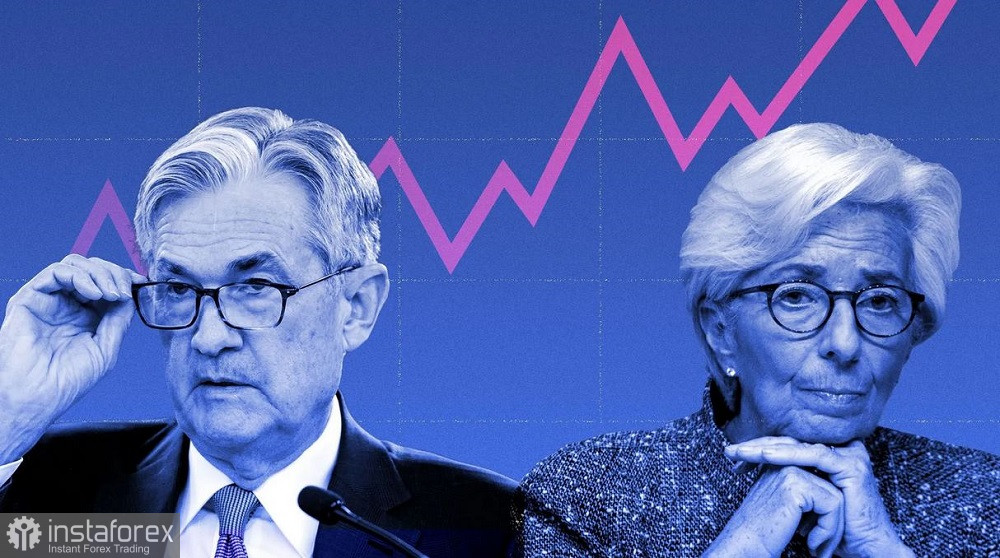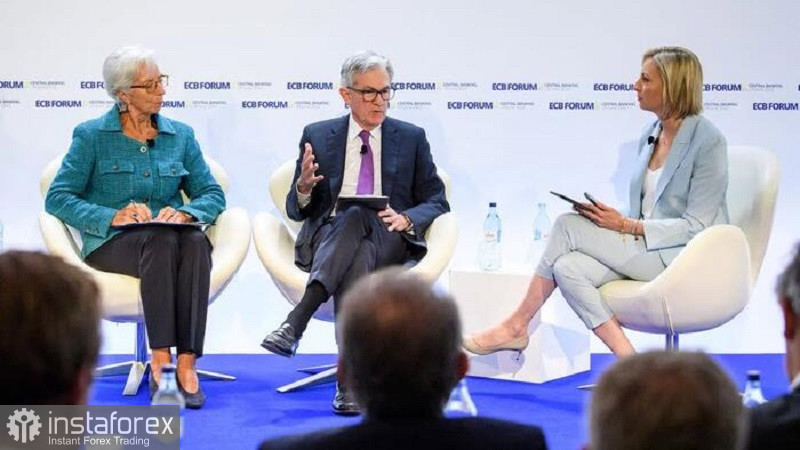"Incredible transformations" is how one could describe in a nutshell the speeches of Christine Lagarde, the President of the European Central Bank, and Jerome Powell, the Chairman of the Federal Reserve, at the ECB forum in Sintra. The tone of their rhetoric unexpectedly changed, surprising market participants. Powell took a more hawkish position compared to his recent statements, while Lagarde, on the contrary, showed unusual caution in her remarks.

The market reaction was somewhat fragmented: after the speech by the head of the Federal Reserve, the US dollar index rallied, and the EUR/USD pair plunged back into the 1.08 range, reaching a two-week price low. But that was it: the "minimum program" was fulfilled, after which traders hurried to lock in their profits. The EUR/USD pair comfortably returned to the 1.09 area, and the dollar index retreated from its local highs. We will discuss the reasons for such indecisiveness a little later, but for now, let's delve into the actions of the Fed chief, who has been shifting the focus of his rhetoric over the past two weeks.
First and foremost, Jerome Powell's recent public activity. He engaged with journalists following the June meeting, then twice presented the semiannual report to Congress (answering lawmakers' questions), and now he is participating in the ECB forum. Throughout this time, his rhetoric gradually became more stringent. Not dramatically so, but the trend was visible. For example, at the post-meeting press conference, Powell exerted pressure on the greenback (although the accompanying statement had a hawkish tone). He stated that the central bank would continue making decisions "meeting by meeting." The June pause was made "out of caution" to gather more information before deciding whether to raise rates again or not, as the pace of tightening monetary policy is "now less important than the search for the end point of the current cycle."
Against the backdrop of such rhetoric, the dollar once again came under pressure. However, the situation changed slightly later (literally within a week). The fact is that the second part of Powell's testimony to Congress had a rather hawkish character. He emphasized that inflation in the US remained unacceptable, and although the pace of price growth had slowed, it was still far from target levels. Consequently, the Federal Reserve has only one option but to continue raising rates in the future. He allowed two rate hikes by the end of 2023 ("it would be appropriate to raise rates again this year, possibly twice more").
As we can see, in Congress, Powell questioned the second rate hike this year while emphasizing that the dot plot is not an action guide. However, yesterday, the head of the Federal Reserve tightened his rhetoric, stating that the "vast majority of members of the American regulator expect two or more rate hikes by the end of the current year." He also confirmed that policy tightening would continue due to a strong labor market and high inflation. He noted that tension in the US banking system had eased, deposit flows had stabilized, and this factor would not serve as a "stop valve" for the Federal Reserve. According to Powell, the Federal Reserve System's bank stress tests showed that major US banks "have a good chance of surviving even a severe recession and continuing to lend."
Such rhetoric provided support to the dollar, but this support was temporary.
The dollar didn't believe Powell
Even before Powell's speech, the market was practically certain that the Fed would raise interest rates by 25 basis points at the July meeting. Currently, the probability of this scenario being realized is estimated at 85% (according to the CME FedWatch Tool), while yesterday and last week, this probability was assessed at 70-75%. At the same time, the probability of maintaining the status quo at the September meeting (assuming a rate hike in July) remains at 65%.

In other words, Powell's "hawkish revelations" did not significantly affect the market's hawkish expectations. This is because the head of the Fed essentially "tied" the prospects of monetary policy tightening to the dynamics of inflationary growth. According to his words, despite the hawkish sentiment of many Committee members, the regulator still needs to decide on the tactics for future rate hikes. For example, according to him, core inflation in the US likely rose 4.7% in May. If this indicator comes out lower than this value tomorrow, hawkish expectations regarding the Fed's actions after the July meeting will weaken again. Therefore, market participants are quick to make trading decisions.
And what about Lagarde?
As for Christine Lagarde, she softened her rhetoric a bit during her speech yesterday. On the one hand, she once again confirmed that the European Central Bank is likely to raise rates by 25 basis points next month. But on the other hand, Lagarde refrained from confirming any further steps later this year. Although her rhetoric had been bolder before - she hinted quite transparently at further rate hikes after the July decision.
Judging by the price dynamics, EUR/USD traders couldn't solve yesterday's puzzle. Powell strengthened the greenback's position but didn't trigger a dollar rally (especially in anticipation of the release of PCE index growth data). Lagarde, in turn, put some pressure on the euro but didn't "sink" the single currency, as Friday's inflation report in the eurozone could redraw the fundamental picture for the EUR/USD pair. As a result, traders couldn't break out of the price range of 1.0880-1.0980, within which they have been trading for the second consecutive week.
It is advisable to adopt a wait-and-see position on the pair: tomorrow's inflation reports could trigger price turbulence. Whether it favors buyers or sellers is an open question.
 English
English 
 Русский
Русский Bahasa Indonesia
Bahasa Indonesia Bahasa Malay
Bahasa Malay ไทย
ไทย Español
Español Deutsch
Deutsch Български
Български Français
Français Tiếng Việt
Tiếng Việt 中文
中文 বাংলা
বাংলা हिन्दी
हिन्दी Čeština
Čeština Українська
Українська Română
Română

